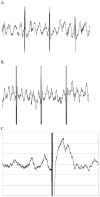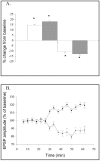Stimulation in hippocampal region CA1 in behaving rats yields long-term potentiation when delivered to the peak of theta and long-term depression when delivered to the trough
- PMID: 14684874
- PMCID: PMC6740943
- DOI: 10.1523/JNEUROSCI.23-37-11725.2003
Stimulation in hippocampal region CA1 in behaving rats yields long-term potentiation when delivered to the peak of theta and long-term depression when delivered to the trough
Abstract
Experimental evidence suggests that the hippocampal theta rhythm plays a critical role in learning. Previous studies have shown long-term potentiation (LTP) to be preferentially induced with stimulation on the peak of local theta rhythm in region CA1 in anesthetized rats and with stimulation of the perforant path at the peak of theta in both anesthetized and behaving animals. We set out to determine the effects of tetanic burst stimulation in stratum radiatum of region CA1 in awake behaving animals, delivered during either the peak or the trough of the theta rhythm in the EEG. Bursts delivered to the peak resulted in an increase of 17.9 +/- 0.94% in potential slope. When identical stimulation bursts were delivered to the trough of local theta waves, the potential slope decreased 12.9 +/- 1.03%. This is the first report of LTP being preferentially induced at the peak of local theta rhythm in behaving animals in region CA1 and that LTD was found in response to tetanic stimulation at the trough of the local theta wave. The results are discussed within the framework of a recent theory that proposes that the theta rhythm sets the dynamics for alternating phases of encoding and retrieval (Hasselmo et al., 20021).
Figures




References
-
- Berry SD, Seager MA ( 2001) Hippocampal theta oscillations and classical conditioning. Neurobiol Learn Mem 76: 298-313. - PubMed
-
- Brankack J, Stewart M, Fox SE ( 1993) Current source density analysis of the hippocampal theta rhythm: associated sustained potentials and candidate synaptic generators. Brain Res 615: 310-327. - PubMed
-
- Brown TH, Chapman PF, Kairiss EW, Keenan CL ( 1988) Long-term synaptic potentiation. Science 242: 724-728. - PubMed
-
- Buzsaki G, Leung LW, Vanderwolf CH ( 1983) Cellular bases of hippocampal EEG in the behaving rat. Brain Res 287: 139-171. - PubMed
-
- Cummings JA, Mulkey RM, Nicoll RA, Malenka RC ( 1996) Ca2+ signaling requirements for long-term depression in the hippocampus. Neuron 16: 825-833. - PubMed
Publication types
MeSH terms
Grants and funding
LinkOut - more resources
Full Text Sources
Other Literature Sources
Miscellaneous
